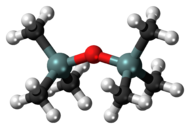Hexamethyldisiloxane
 |
|
 |
|
| Names | |
|---|---|
|
Preferred IUPAC name
Hexamethyldisiloxane
|
|
| Other names
Bis(trimethylsilyl) ether
Bis(trimethylsilyl) oxide |
|
| Identifiers | |
|
3D model (JSmol)
|
|
| Abbreviations | HMDSO, (TMS)2O |
| 1736258 | |
| ChEBI | |
| ChemSpider | |
| ECHA InfoCard | 100.003.176 |
| EC Number | 203-492-7 |
| MeSH | Hexamethyldisiloxane |
|
PubChem CID
|
|
| RTECS number | JM9237000 |
| UNII | |
| UN number | 1993 |
|
|
|
|
| Properties | |
| C6H18OSi2 | |
| Molar mass | 162.38 g·mol−1 |
| Appearance | Colourless liquid |
| Density | 0.764 g cm−3 |
| Melting point | −59 °C (−74 °F; 214 K) |
| Boiling point | 100 to 101 °C (212 to 214 °F; 373 to 374 K) |
| 930.7±33.7 ppb (23 °C) | |
| Vapor pressure | 43 hPa (20 °C) |
|
Refractive index (nD)
|
1.377 |
| Hazards | |
| Main hazards | Highly flammable liquid and vapour Causes serious eye irritation |
|
EU classification (DSD) (outdated)
|
|
| R-phrases (outdated) | R11 |
| S-phrases (outdated) | S16 |
| NFPA 704 | |
| Flash point | -1(1) °C |
| Related compounds | |
|
Related compounds
|
Disiloxane Tetramethylsilane |
|
Except where otherwise noted, data are given for materials in their standard state (at 25 °C [77 °F], 100 kPa).
|
|
|
|
|
| Infobox references | |
Causes serious eye irritation
Tetramethylsilane
Dimethyl ether
Bis(trimethylsilyl)amine Tetrakis(trimethylsilyloxy)silane
Hexamethyldisiloxane (HMDSO) is an organosilicon compound with the formula O[Si(CH3)3]2. This volatile colourless liquid is used as a solvent and as a reagent in organic synthesis. It is prepared by the hydrolysis of trimethylsilyl chloride. The molecule is the protypical disiloxane and resembles a subunit of polydimethylsiloxane.
Hexamethyldisiloxane can be produced by hydrolysis of trimethylsilyl chloride:
It also results from the hydrolysis of silylethers and other silyl-protected functional groups. HMDSO can be converted back to the chloride by reaction with Me2SiCl2.
Hexamethyldisiloxane is mainly used as source of the trimethylsilyl functional group (-Si(CH3)3) in organic synthesis. For example, in the presence of acid catalyst, it converts alcohols and carboxylic acids into the silyl ethers and silyl esters, respectively.
It reacts with rhenium(VII) oxide to give the silanoate complex:
HMDSO is used as an internal standard for calibrating chemical shift in1H NMR spectroscopy. It is more easily handled since it is less volatile than the usual standard tetramethylsilane but still displays only a singlet near 0 ppm.
...
Wikipedia

